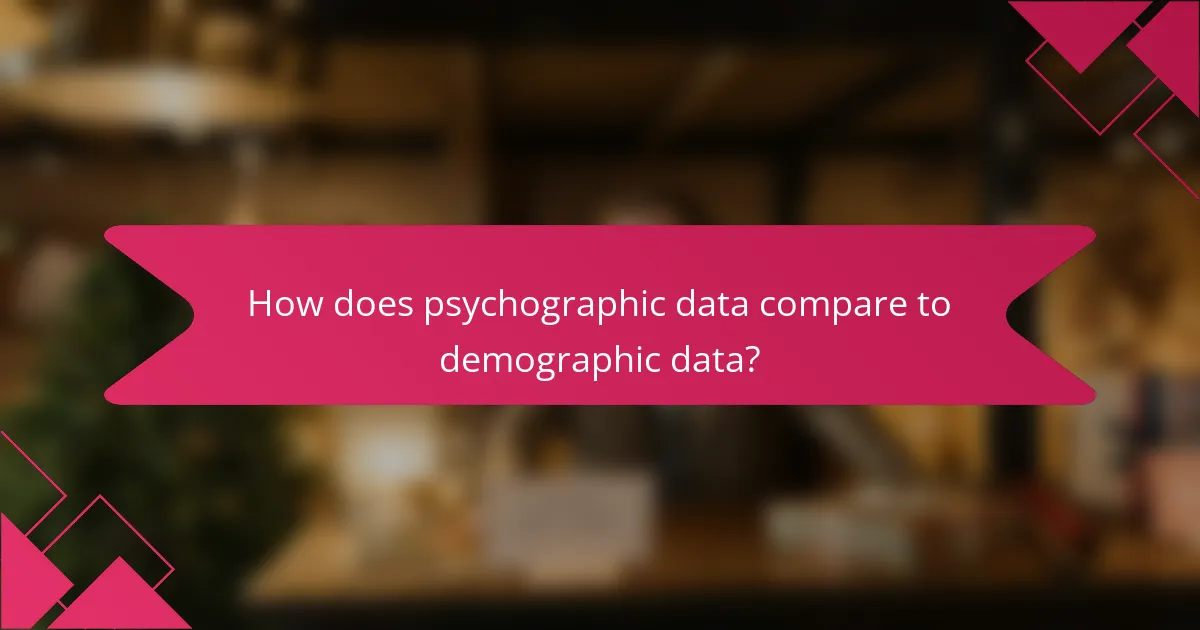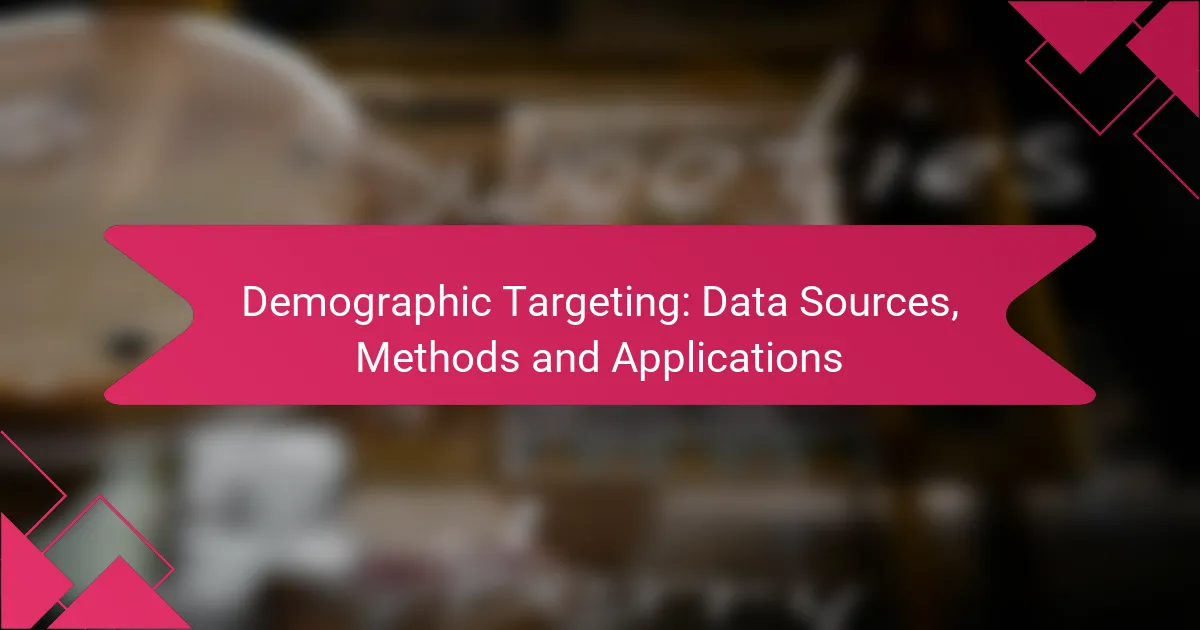Psychographics play a crucial role in enhancing ad effectiveness by enabling marketers to customize their messages according to consumer values, interests, and lifestyles. By understanding key segments such as personality traits and beliefs, marketers can create more relevant advertising that significantly boosts engagement and conversion rates.

How can psychographics improve ad effectiveness?
Psychographics enhance ad effectiveness by allowing marketers to tailor their messages based on consumer values, interests, and lifestyles. This deeper understanding of target audiences leads to more relevant advertising, which can significantly boost engagement and conversion rates.
Targeted messaging
Targeted messaging involves crafting advertisements that resonate with specific psychographic segments. By understanding the motivations and preferences of different groups, brands can create messages that speak directly to their desires and pain points. For example, a fitness brand might focus on health-conscious consumers by highlighting sustainability and wellness in their campaigns.
To implement targeted messaging effectively, conduct thorough research to identify key psychographic traits within your audience. Utilize surveys, social media insights, and customer feedback to gather data that informs your messaging strategy.
Enhanced audience engagement
Enhanced audience engagement results from delivering content that aligns with the interests and values of consumers. When ads reflect the lifestyle and beliefs of the target demographic, they are more likely to capture attention and foster interaction. For instance, brands that support social causes may engage consumers who prioritize ethical consumption.
To boost engagement, consider using storytelling techniques that connect emotionally with your audience. Incorporating user-generated content or testimonials can also strengthen this connection, making consumers feel more involved with the brand.
Increased conversion rates
Increased conversion rates occur when ads are tailored to meet the specific needs and preferences of psychographic segments. By aligning product offerings with consumer motivations, brands can encourage more purchases. For example, a luxury brand might appeal to aspirational consumers by emphasizing exclusivity and status in their advertising.
To maximize conversion rates, test different ad variations to see which messages resonate best with your audience. Monitor performance metrics closely and adjust your strategies based on what drives the most engagement and sales.

What are the key psychographic segments?
Key psychographic segments include personality traits, values and beliefs, and lifestyles and interests. Understanding these segments helps marketers tailor their strategies to resonate with specific consumer groups.
Personality traits
Personality traits categorize individuals based on their consistent patterns of thinking, feeling, and behaving. Common traits include openness, conscientiousness, extraversion, agreeableness, and neuroticism. For example, a highly conscientious person may prefer brands that emphasize quality and reliability.
Marketers can use personality assessments to segment their audience effectively. By aligning products with the traits of target segments, brands can enhance engagement and loyalty. For instance, adventurous personalities may respond well to outdoor gear brands that promote exploration and excitement.
Values and beliefs
Values and beliefs shape consumer preferences and purchasing decisions. These can include ethical considerations, cultural influences, and personal convictions. For instance, consumers who prioritize sustainability are likely to support brands that demonstrate environmental responsibility.
Understanding the values of target segments allows marketers to craft messages that resonate deeply. Brands that align their missions with consumer beliefs can foster stronger connections. For example, a company promoting fair trade practices may attract consumers who value social justice.
Lifestyles and interests
Lifestyles and interests encompass the activities, hobbies, and daily habits of individuals. This segmentation can reveal preferences for leisure activities, travel, and entertainment. For example, a consumer who enjoys fitness may be more inclined to purchase health-related products.
Marketers should consider lifestyle factors when developing campaigns. Tailoring messages to specific interests can enhance relevance and engagement. For instance, a brand targeting tech enthusiasts might focus on innovation and cutting-edge features in their advertising.

How to conduct psychographic segmentation?
Psychographic segmentation involves categorizing consumers based on their psychological attributes, such as values, interests, and lifestyles. This approach helps marketers tailor their strategies to resonate with specific audience segments, enhancing engagement and effectiveness.
Surveys and questionnaires
Surveys and questionnaires are effective tools for gathering psychographic data directly from consumers. By asking targeted questions about preferences, values, and lifestyle choices, businesses can gain insights into the motivations behind purchasing behavior.
When designing surveys, consider using a mix of open-ended and closed-ended questions to capture qualitative and quantitative data. Aim for a sample size that reflects your target market, ideally in the low hundreds to ensure diverse responses.
Social media analysis
Social media analysis provides a wealth of psychographic information by examining user interactions, comments, and shared content. Platforms like Facebook, Instagram, and Twitter can reveal trends in interests and values through engagement metrics and sentiment analysis.
Utilize social listening tools to track brand mentions and discussions relevant to your industry. This can help identify key themes and consumer sentiments, allowing for more nuanced segmentation based on real-time data.
Focus groups
Focus groups involve gathering a small group of individuals from your target market to discuss their attitudes and perceptions. This qualitative method allows for in-depth exploration of psychographic factors, providing context that surveys may miss.
When conducting focus groups, ensure a diverse mix of participants to capture a range of perspectives. Prepare a discussion guide with open-ended questions to facilitate conversation, and consider recording sessions for detailed analysis later.

What tools are available for psychographic analysis?
Several tools can facilitate psychographic analysis, helping businesses understand consumer behaviors, attitudes, and preferences. These tools range from survey platforms to analytics software, each offering unique features to gather and interpret psychographic data.
Qualtrics
Qualtrics is a robust platform designed for advanced survey creation and data analysis, making it ideal for psychographic research. It allows users to design customized surveys that can capture detailed insights into consumer motivations and preferences.
Key features include advanced logic and branching capabilities, enabling tailored questions based on previous responses. This ensures that the data collected is relevant and specific to the target audience, enhancing the quality of psychographic insights.
SurveyMonkey
SurveyMonkey is a user-friendly tool for creating and distributing surveys, suitable for gathering psychographic data quickly. It offers a variety of templates and question types, making it easy to assess consumer attitudes and lifestyle choices.
With its analytics dashboard, users can easily interpret results and visualize data trends. However, while it is accessible for beginners, more complex psychographic analysis may require additional tools or integration with other data sources.
Google Analytics
Google Analytics provides valuable insights into user behavior on websites, which can be leveraged for psychographic analysis. By tracking metrics such as user engagement and demographics, businesses can infer psychographic characteristics of their audience.
Utilizing features like audience segmentation and custom reports allows for deeper analysis of consumer interests and preferences. However, it is essential to combine this quantitative data with qualitative insights from surveys for a comprehensive understanding of psychographics.

What are the benefits of psychographic insights in marketing?
Psychographic insights enhance marketing strategies by providing a deeper understanding of consumer motivations, preferences, and behaviors. These insights allow marketers to create more personalized campaigns that resonate with target audiences, ultimately leading to improved engagement and conversion rates.
Improved targeting precision
Psychographic insights enable marketers to refine their targeting by focusing on consumers’ values, interests, and lifestyles rather than just demographics. This precision helps in crafting messages that speak directly to the emotional and psychological drivers of potential customers.
For instance, a brand selling eco-friendly products can target environmentally conscious consumers by highlighting sustainability in their messaging. This targeted approach can significantly increase the effectiveness of marketing campaigns.
Better customer retention
Understanding the psychographics of existing customers can lead to enhanced retention strategies. By knowing what drives customer loyalty, businesses can tailor their communication and offerings to meet these specific needs.
For example, a subscription service might analyze customer preferences to provide personalized recommendations, thus increasing satisfaction and reducing churn. Engaging customers based on their values fosters a stronger brand connection.
Informed product development
Psychographic insights can guide product development by identifying gaps in the market that align with consumer desires. By understanding what motivates customers, companies can innovate products that better meet their needs.
For instance, a tech company might discover through psychographic research that consumers prioritize user-friendly interfaces over advanced features. This insight can direct the design process to focus on simplicity and usability, leading to a more successful product launch.

How does psychographic data compare to demographic data?
Psychographic data provides insights into consumer motivations, values, and lifestyles, while demographic data focuses on quantifiable characteristics like age, gender, and income. Understanding both types of data allows marketers to create more effective strategies by aligning their messages with the underlying reasons behind consumer behavior.
Deeper understanding of motivations
Psychographic data delves into the reasons behind consumer choices, offering insights into their beliefs, interests, and emotional triggers. For instance, a brand targeting environmentally conscious consumers can tailor its messaging to highlight sustainability practices, resonating more deeply than demographic information alone would allow.
Marketers can segment audiences based on psychographic profiles, such as values-driven or experience-seeking consumers. This segmentation helps in crafting personalized marketing campaigns that speak directly to the motivations of each group, enhancing engagement and loyalty.
Behavioral predictions
Psychographic insights can significantly improve the accuracy of behavioral predictions. By understanding consumer motivations, brands can anticipate purchasing patterns and preferences, leading to more effective product recommendations and advertising strategies. For example, a brand may find that consumers who prioritize health and wellness are more likely to purchase organic products.
Utilizing psychographic data allows for the development of targeted campaigns that align with consumers’ lifestyles. Marketers should consider creating tailored content that reflects the values and interests of their audience, which can lead to increased conversion rates and customer satisfaction.









